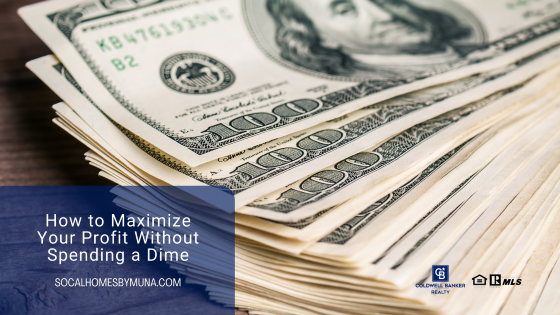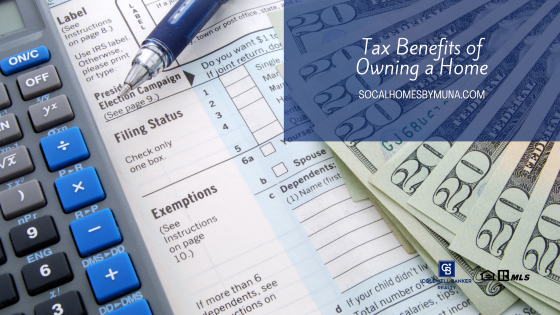How to Maximize Your Profit Without Spending a Dime

For the past couple of years, sellers really benefited from the real estate market. In many instances, simply announcing a sale brought on a feeding frenzy of buyers. Many of those buyers paid well above asking simply to secure the sale. Unfortunately, the days of bidding wars and low to no effort by the seller appear to be waning as the market begins to balance itself. Fortunately, while you must make some effort to snag a buyer, you do not need to break the bank to maximize your profit on a sale. Use these cost-friendly tips to make sure you receive the highest sale price possible for your Inland Empire property.
How to Maximize Your Profit Without Spending a Dime
Proper Pricing is Rule #1
If a home sits on the market for several weeks, most likely, the list price is to blame. Always, always talk to your REALTOR® about neighborhood comps. These show you what similar homes to yours sold for recently. That provides a picture of what you may realistically expect to receive for your Inland Empire home. Then, listen to your real estate agent’s opinion. They know the market and current trends. They also want to sell this home as much as you do. So, their educated advice is well worth considering when deciding on a list price.
Additionally, think strategically about pricing. Perhaps list it slightly below market. Or consider a sales trick as old as time…the power of “9’s”. For example, instead of listing for $605,000, price it at $599,999 instead. This sounds slightly better. Also, it helps you with the search parameters for buyers looking online. Let’s say they want to search for properties under $600,000. So, they set their search at homes between $500,000 and $599,999. If you price your property at $600,000, it will not show up. But, if you price it slightly less, it will.
Maximize Your Online Profile
Studies show that a majority of buyers utilize the internet at some point during their home search. In fact, in many cases, this may be the first time they see your property. Therefore, you need to ensure that they see it in its very best light. Professional photos and videos make all the difference in how buyers assess your property. Oftentimes, real estate agents include these with their services.
Also, make sure you let your REALTOR® know all of the positive aspects of your home that appeal to a buyer the most. For example, how close is it located to parks, entertainment, shopping, schools, and restaurants? Did you recently upgrade appliances, the HVAC system, or flooring? Is the backyard fenced-in (good for kids and pets)? Single-story properties appeal to older buyers and those with physical limitations. These should all be included in the description to offer as precise a picture for the buyer as possible.
Clear Out the Clutter
Finally, get rid of the “excess”. Pack up, donate, or dump items you do not use on a regular basis. This includes packing away all personal items such as family photos, children’s artwork, and personal collections of any sort. Take one-third to one-half of the clothing out of each closet. This makes the closets all appear much larger (something all buyers want to see). Pare down your kitchenware to just the basic necessities for this same reason. (Buyers open every cabinet, every drawer, and every door.) Store all of these as well as your bigger, bulkier furniture in a storage unit or at a friend’s/family member’s home if possible until you sign your final paperwork.
When you decide that you want to list your Inland Empire home on the market, contact me. I am always happy to help.
Muna Dionne, your Inland Empire specialist with Coldwell Banker Realty
How to Get Rid of Stinky Odors Before Listing Your Home

When you decide to sell your Inland Empire home, you need to tackle a few chores first. Staging. Repairing. Cleaning. But one thing we sometimes overlook is how our house smells. Even if you are fastidious about cleaning your home, it may include some odors that you just grew used to while living there. Unfortunately, buyers may take a whiff and decide that they do not want to make your home their home. Avoid this negative reaction. Get rid of stinky odors before you even list your property and buyers will never know the funky smells existed in the first place.
How to Get Rid of Stinky Odors in Your Inland Empire Home
Pet and Cigarette Odors
Two of the strongest smells (and some of the toughest ones to eliminate) are cat urine and cigarette smoke. For pets, deep clean the carpets and use a pet enzyme removal product. Then, empty out the litter box daily and before every showing. For cigarette smoke, you need to deep clean all soft surfaces (such as upholstered furniture carpet, drapes, etc.). But you also need to scrub the walls, baseboards, ceilings, and windows to remove any residual tobacco smell. Even if a smoker goes outside, they bring those smells inside with them on their clothes, in their hair, and on their fingers.
Smelly Carpets
Speaking of carpets, these tend to soak up stench from everyday wear and tear. You can get rid of stinky odors by first thoroughly steam cleaning the carpets. This lifts dirt and grime from way down deep under the carpet. Many grocery stores and home improvement stores rent out steam cleaners. But if the carpet is well beyond a good steam cleaning, you may have to rip it up and either replace it with a new carpet or hardwood. If your Inland Empire home includes carpet in the bathroom, replace it with tile right away. No buyer wants to see (or smell) that.
Moldy Smell in the AC
Sometimes, water droplets (aka, condensation) collect inside your air conditioning unit. This may lead to a moldy/mildewy smell. First, tackle the funk with a good scrubbing. Clean off the coils, as well. Then, replace the filter. Sometimes the smells get trapped in there, too.
Burning Smell From the Furnace
Like the AC unit, your furnace may accumulate dirt and dust that settles in the floor ducts. That is why you may detect a slight burning smell when the furnace first gets turned on after the weather begins to cool off. A thorough cleaning of your air ducts should remedy this situation right away.
Mustiness
Typically, mustiness results from a water leak. But do not be scared off by that. All leaks should be identified and remediated right away. For smaller leaks, white vinegar and a dry cloth help eliminate the musty smell. Larger leaks may require more intense efforts.
Stale Air
Lastly, if you find that the air in your Inland Empire home simply smells “stale”, open your windows for a few hours once a week to let the fresh air in. Before a showing, make sure you open all of your windows as well. The circulating air helps move stale air out and allows fresh air inside.
Muna Dionne, your Inland Empire specialist with Coldwell Banker Realty
First-Time Home Seller Tips

It is inevitable. At some point, most first-time home buyers eventually become first-time home sellers. The Inland Empire real estate market (much like the rest of the country) experienced one heck of a ride over the past few years, While we are still considered a seller’s market at this point, things are beginning to move towards a more balanced market. That may actually help deals happen rather than hinder them. But before you list your property for sale, make sure that you follow these first-time home seller tips and avoid common mistakes first-timers often make.
First-Time Home Seller Tips
Price Your Property Appropriately
Professionals cite pricing as the #1 reason most properties stay on the market for an extended period of time. In this fast-paced real estate climate, you need to price your Inland Empire home according to the most current trends. In fact, sometimes pricing it just below market may not only nab you a buyer quickly but could, in fact, garner enough interest to receive multiple offers. Oftentimes, this drives your final sale price up as well. But talk it over with your REALTOR® first because you run the risk of only receiving one offer at the below market list price. They can help you determine whether this is a good course of action or not.
Home Staging
Staging can mean the difference between a home sold in a matter of days and one that stays on the market for a while. Also, studies show that staged homes sell for more money than unstaged ones. Professional stagers cost money. But they also know how to make each area of your property look its absolute best. If this is not in your budget, ask your REALTOR® for staging tips that you can do on your own.
Make Your Home Available for Showings at Any Time
Selling a home is not always convenient when it comes to time management. But you should never limit your availability for viewings. This may mean taking Fido for a long walk or running errands with the kids while a buyer takes a tour of your home. (Yes. You DO need to be out of the house when this happens.) But if that is what it takes to get a sale done, that’s what you need to do.
Consider Offers Carefully
Finally, you do not always need to accept the first offer you receive. Money is great. But it is not the only reason to accept an offer. Other things to look for include strong financing (as well as the type of financing), the amount of time requested in escrow, and contingencies. More contingencies provide more of an opportunity for something to go wrong. At the same time, an incredibly high dollar amount offered for a property “sight unseen” may be too good to be true. Let your REALTOR® do their homework to see whether or not an offer is as good as it looks before accepting or countering.
As a first-time home seller, you may think that sky-high prices are the norm. They’re not. Please remember that our hot, hot seller’s market appears to be cooling off a bit. Now, that does not mean that prices or sales will plunge into oblivion anytime soon. But as interest rates rise and financing becomes more expensive, buyer interest may wane. If you receive a good, solid offer, take it now. If you wait for prices to “reach their peak”, you may miss out on a good deal. We cannot predict when that may happen. Work in the market that is happening right now, not what you “think” may happen in the future. And contact me when you are ready to sell your Inland Empire home.
Muna Dionne, your Inland Empire specialist with Coldwell Banker Realty
Pricing Your Home to Sell

The days of receiving tens of thousands of dollars above asking in mere days of listing your Inland Empire home may be a thing of the past. Yes. We are still in a seller’s market. And, yes, we sometimes still see sellers who receive more than one offer on their homes. However, over one-third of the houses on the market in Riverside County saw a price cut last month. Staging your home and making necessary repairs before you list are only parts of the total home sale equation. If you wish to find a buyer quickly, you really need to price your home correctly to begin with. That means paying attention to current market trends.
Pricing Your Home to Sell
Hire a Local REALTOR®
How does hiring a local REALTOR® help you with pricing your home to sell? Well, a local REALTOR® knows the local market. They also know current market trends in that specific area. Fortunately, a good Inland Empire REALTOR® also has many resources at their fingertips to help you set a competitive price for your home that brings buyers to your door.
Using Comps
Your REALTOR® can research recently sold “comps” in the area for you. These are properties similar in size, location, and age to your own. Look for price reductions and how long they sat on the market before they went under contract. Multiple reductions and long days on the market usually mean the seller priced their property too high.
Withdrawn and Expired Listings
See how many sellers ended up withdrawing their listings from the market. Also, take note of expired listings. Withdrawn means that the seller decided to take it off the market. Expired means that the listing agreement between the seller and their agent ran out of time without a sale taking place. Ask your agent to find out why these listings either were withdrawn or expired. Many times, the answer could be due to listing it too high. However, that is not always the case.
Strategize
You can handle pricing your home one of two ways: at market value or slightly below market value. Either way, keep emotion out of the equation. Your REALTOR® will give you their opinion of a good list price based on comps and current market trends. And I highly recommend that you take their experienced opinion into account when you decide on a list price. Ask them if they believe listing it slightly below market value might work in your favor. Keep in mind that this is a gamble because you may end up only receiving one offer at that lower price. On the flip side, it might also encourage several buyers to put their offers in, creating a bidding war and driving the price up. Discuss this option with your REALTOR® to determine if that is a strategy you wish to pursue or not.
Muna Dionne, your Inland Empire specialist with Coldwell Banker Realty


 Facebook
Facebook
 X
X
 Pinterest
Pinterest
 Copy Link
Copy Link





